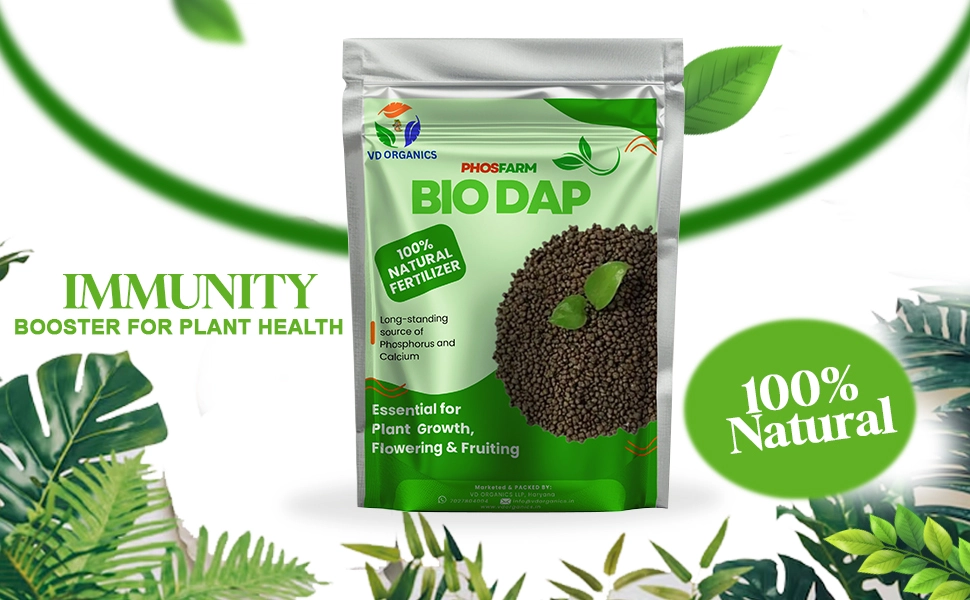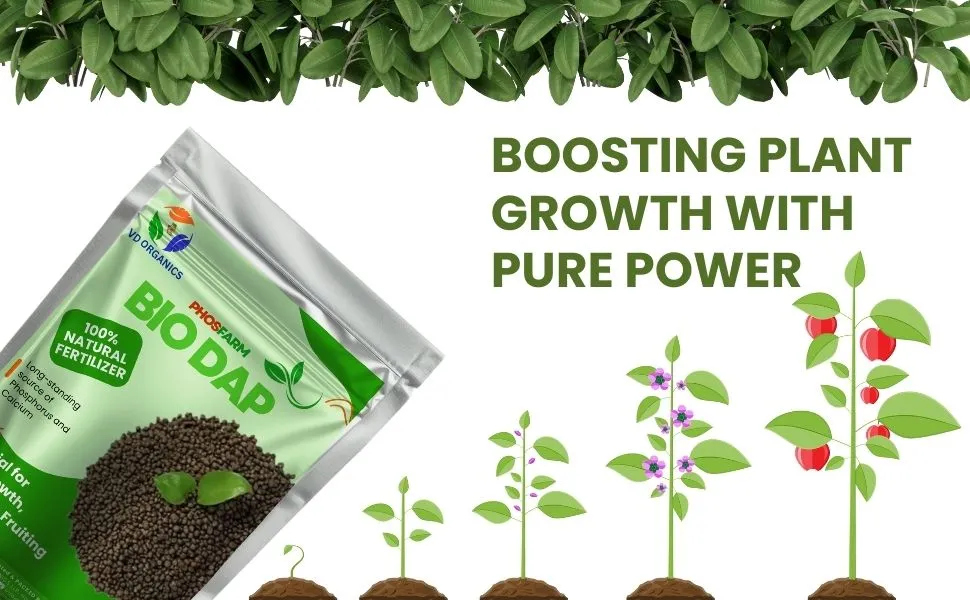Gardeners and farmers constantly seek ways to enhance crop productivity while protecting the environment. Bio-DAP fertilizer stands out as a powerful option that merges essential nutrients with natural elements for optimal results. This innovative blend delivers phosphorus and nitrogen in a form that nurtures plants without harming the soil. By incorporating Bio-DAP fertilizer into your routine, you can achieve healthier yields and contribute to eco-conscious practices.
Understanding this type of fertilizer opens doors to better agricultural decisions. It draws from sustainable sources, ensuring that your gardening efforts align with long-term ecological goals. Whether you’re tending a backyard plot or managing large fields, grasping its core features can transform how you approach plant nutrition.

What Makes Bio-DAP Fertilizer Unique?
At its heart, this fertilizer combines organic matter with key minerals to create a balanced nutrient profile. Derived from composted plant and animal residues, it provides a natural base that enriches the earth. The inclusion of concentrated phosphorus and nitrogen mimics traditional options but with an organic twist, making it gentler on ecosystems.
One standout aspect is how it supports microbial life in the soil. Beneficial bacteria and fungi thrive in this environment, breaking down components slowly. This process not only feeds plants over time but also improves the ground’s texture, allowing better water retention and root penetration. Unlike quick-acting synthetics, this approach minimizes waste and promotes resilience against droughts or heavy rains.
Farmers appreciate its adaptability to different soil types. Whether dealing with clay-heavy or sandy terrains, the organic elements help bind particles together or loosen compacted areas. This versatility ensures consistent performance across various conditions, reducing the need for multiple products.
Key Benefits for Plant Health and Growth
Using this fertilizer leads to noticeable improvements in vegetation vitality. Plants receive a steady supply of essentials, resulting in stronger stems, deeper roots, and more robust foliage. This foundation supports everything from early seedling stages to mature harvesting, ensuring crops reach their full potential.
A major advantage lies in its role in flowering and fruit development. Phosphorus plays a crucial part in energy transfer within plants, aiding in the formation of blooms and seeds. Combined with nitrogen for leaf growth, it creates a harmonious boost that enhances overall yield quality. Gardeners often report brighter colors in flowers and sweeter tastes in produce.
Beyond immediate gains, long-term soil enhancement is a highlight. Regular application builds organic matter levels, which act as a buffer against nutrient deficiencies. This means fewer interventions over seasons, saving time and resources while fostering a self-sustaining cycle.
Enhancing Soil Structure Naturally
Delving deeper, the composted materials in this fertilizer improve porosity and aeration. Roots access oxygen more easily, which is vital for metabolic processes. Over time, this leads to healthier microbial communities that decompose residues efficiently, recycling nutrients back into the system.
Water-holding capacity also sees a uplift. Organic components absorb moisture like a sponge, releasing it gradually during dry spells. This reduces irrigation needs and prevents erosion, especially on sloped lands. For areas prone to nutrient leaching, the slow-release mechanism keeps elements in place, protecting nearby water sources.
Promoting Sustainable Yields
Sustainability is at the forefront with this choice. It cuts down on runoff that can pollute rivers and lakes, a common issue with conventional alternatives. By focusing on gradual nutrient delivery, it aligns with principles of regenerative agriculture, where the goal is to give back to the land as much as taken.
Crops treated this way often show increased resistance to pests and diseases. Healthier plants with balanced nutrition are less appealing to invaders, reducing reliance on chemical interventions. This holistic benefit appeals to those aiming for cleaner, greener operations.
How Bio-DAP Fertilizer Works in the Soil
The magic happens through a controlled breakdown process. Organic matter decomposes via microbial action, unlocking phosphorus and nitrogen bit by bit. This mimics nature’s rhythm, avoiding the shock of sudden surges that can burn roots or cause imbalances.
Phosphorus binds with soil particles, making it available when plants need it most, like during rapid growth phases. Nitrogen, meanwhile, fuels protein synthesis for vigorous expansion. Together, they ensure efficient uptake without excess accumulation that could harm the environment.
Environmental factors influence its efficacy. Warmer temperatures accelerate decomposition, while cooler climates slow it for extended release. Adjusting application rates based on soil tests maximizes outcomes, tailoring the approach to specific needs.
The Role of Microbes in Nutrient Release
Beneficial organisms are key players here. They colonize the root zone, forming symbiotic relationships that enhance absorption. In return, plants exude sugars that feed these microbes, creating a mutually beneficial loop.
This interaction also suppresses harmful pathogens, maintaining a balanced ecosystem underground. Over seasons, biodiversity increases, leading to more resilient soils that withstand stressors like compaction or acidity.
Preventing Nutrient Loss
A critical feature is its low volatility. Unlike some synthetics that evaporate or wash away, the organic binding keeps nutrients anchored. This efficiency translates to cost savings and reduced ecological footprint, making it a smart choice for forward-thinking cultivators.
Versatile Applications Across Crops
This fertilizer shines in diverse settings, from home gardens to commercial farms. For vegetables like tomatoes and lettuce, it encourages lush growth and higher outputs. Fruit trees benefit from improved pollination and juicier harvests, while grains such as wheat or corn develop fuller kernels.
Ornamental plants, too, thrive under its care. Flowers display more vivid hues, and shrubs maintain denser canopies. It’s particularly suited for eco-friendly setups, where avoiding synthetics is a priority.
In organic certification pursuits, it fits seamlessly, meeting standards for natural inputs. Gardeners experimenting with permaculture find it invaluable for companion planting and crop rotations.
Tailoring Use for Specific Plants
Customizing applications yields the best results. Leafy greens may require lighter doses to avoid legginess, while root crops like carrots appreciate deeper incorporation for bulb development. Testing soil pH beforehand ensures compatibility, as neutral to slightly acidic conditions optimize performance.
Seasonal timing matters as well. Spring applications kickstart growth, while fall doses prepare for winter dormancy. Monitoring plant responses allows fine-tuning for peak efficiency.
Integration with Other Practices
Pairing it with mulching amplifies effects, conserving moisture and suppressing weeds. Compost teas or cover crops complement its action, building layered nutrition. This integrated method fosters biodiversity and long-term productivity.
Comparing Bio-DAP to Traditional Options
When stacked against conventional DAP, the differences are stark. Synthetics offer quick fixes but often lead to soil degradation over time. In contrast, this organic variant rebuilds what it uses, promoting fertility cycles.
Environmental impact is lower, with reduced risks of eutrophication in water bodies. While initial costs might seem comparable, the sustained benefits lower overall expenses through fewer reapplications.
User feedback highlights easier handling and safer storage, free from harsh chemicals. Transitioning from traditional methods requires patience, but the rewards in soil vitality make it worthwhile.
Environmental Advantages
By curbing pollution, it supports biodiversity in surrounding habitats. Wildlife benefits from cleaner waterways, and air quality improves without volatile emissions. This aligns with global efforts toward climate-resilient agriculture.
Economic Considerations
Higher upfront investment pays off through increased yields and market premiums for organic produce. Farms adopting this see improved profitability, especially in niche markets valuing sustainability.
Practical Tips for Effective Application
Start with soil analysis to determine baselines. Broadcast evenly across beds or incorporate during tilling for uniform distribution. Watering post-application activates the release, ensuring quick integration.
Avoid over-fertilizing; follow recommended rates to prevent imbalances. For container gardening, mix into potting soil for controlled environments. Regular monitoring through leaf color and growth patterns guides adjustments.
Storage in cool, dry places preserves potency. Always wear gloves during handling for safety, though its natural composition poses minimal risks.
Common Mistakes to Avoid
Skipping soil tests can lead to inefficiencies. Applying during heavy rains risks washout, so time it with weather forecasts. Mixing with incompatible products might dilute effects, so check compatibilities first.
Advanced Techniques
For precision farming, use it in drip irrigation systems for targeted delivery. Combining with bio-stimulants enhances uptake, pushing boundaries for maximum output.
Conclusion: Embracing a Greener Future
Adopting this fertilizer marks a step toward harmonious cultivation. It delivers on promises of growth, health, and sustainability, empowering users to nurture the land responsibly. As awareness grows, more will turn to such solutions for thriving ecosystems and bountiful returns.

